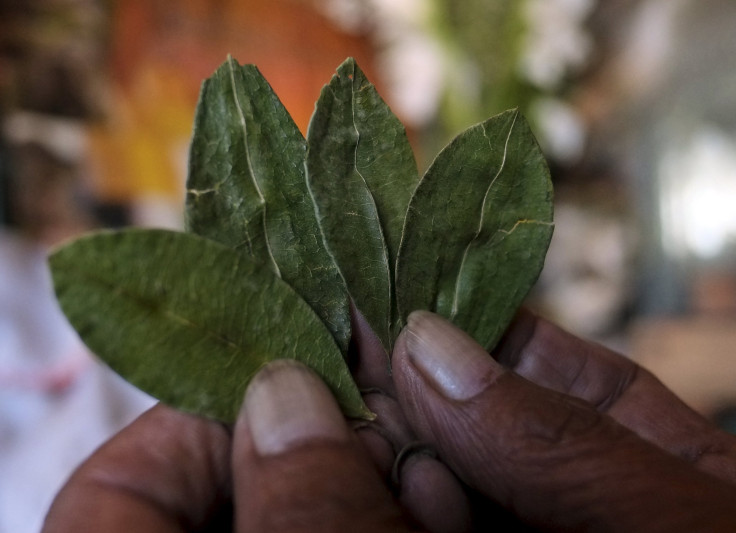Pope Francis Drinks Tea Made Of Coca Leaves — How Cocaine's Main Ingredient Treats Altitude Sickness

While traveling to the highest capital city in the world Wednesday, Pope Francis sipped on a special tea made of chamomile, anise seeds, and the main ingredient in cocaine — coca leaves. Journalists aboard the flight joined the pope in drinking the coca concoction known as Mate de Coca, which is indigenous to the Andean region. For centuries, coca leaves have been medicinally chewed or brewed in tea form to relieve fatigue, suppress hunger and thirst, and ward off altitude sickness.
After walking off the plane, the pope seemed to be in good health as he delivered a welcoming address to the second of three poorest countries he will be visiting in Latin America; Ecuador was the first, with Paraguay next. Before he left, he told a Bolivian minister he wanted to follow their traditional method of chewing on coca leaves, known as acullico. The saliva-soaked ball of leaves would serve as a mild stimulant comparable to coffee, with a cocaine alkaloid level between 0.5 and 1.0 percent.
Cocaine was first isolated from the coca leaf in the 1860s and synthesized into tonics in order to reap its health benefits until the early 20th century. However, it wasn’t until the 1920s that cocaine’s drug dependence and addiction propensity became a true concern among most countries. Laws restricting consumption soon came to the forefront of drug regulation, and a drop in cocaine use followed shortly after.
Without coca there would be no cocaine, and because of this, the United Nation’s Single Convention on Narcotic Drugs, which is the overarching framework that governs international drug policies, listed the leaf as a Schedule 1 drug in 1961. Bolivia received a special exemption from the UN’s decision after arguing that the convention’s rule impeded on their right to “protect native and ancestral coca as cultural patrimony,” because in its natural state, “is not a narcotic.”
The legality and licensing of growing coca leaves in Bolivia is credited with the fall in cocaine production in the country. Because of this, some experts argue the policy should serve as an innovative model for drug reform in other countries. The right of indigenous communities to chew coca has been thriving without abuse, while Bolivia continues to produce between 40 to 45 percent of the world’s supply of coca leaves. The natural remedy for altitude sickness has gone beyond its medicinal benefits and remains as one of the country’s longest standing traditions transcending through every social class within Bolivia’s society.

A Natural Cure for Altitude Sickness
Altitude illness is caused by the stresses of high-altitude environment, according to the Centers for Disease Control and Prevention’s Travel Consultation. For those traveling at high altitudes, like Pope Francis, sickness can strike a person at mild to severe stages — acute mountain sickness (AMS), high-altitude cerebral edema (HACE), and high-altitude pulmonary edema (HAPE). The pope was flying from Ecuador to La Paz, Bolivia, which is home to the highest international airport in the world at over 13,000 feet above sea level.
Gradually acclimating to higher altitudes is ideal for those traveling 8,000 feet or higher; however, it’s easier said than done. The body’s ability to acclimate takes three to five days to incrementally work its way up to higher heights, which can prevent illness, improve sleep, and make it overall easier to breathe. The 78-year-old pope is at greater risk of altitude sickness because he has decreased lung capacity after surviving from an infection as a teenager and having one of his lungs removed.
AMS is the earliest stage of altitude sickness and causes similar feelings to a hangover, causing headaches, nausea, and fatigue and should be taken as a warning sign before your condition worsens. Reaching HAPE or HACE levels can result in fatality within hours, according to Altitude.org. Even during rest, HAPE causes breathlessness, fever, and coughing up frothy spit because an excess of fluid has reached the lungs. HACE is characterized by fluid in the brain, which causes confusion, clumsiness, an extensive emotional state, violence, and shortly before death, drowsiness and loss of consciousness will take over.
The risk of altitude sickness increases if a person ascends faster than 1,500 feet a day, along with vigorous exercise. The pope remained in La Paz for four hours before moving down to Santa Cruz, Bolivia’s largest city, which is at a much lower and amiable altitude.



























